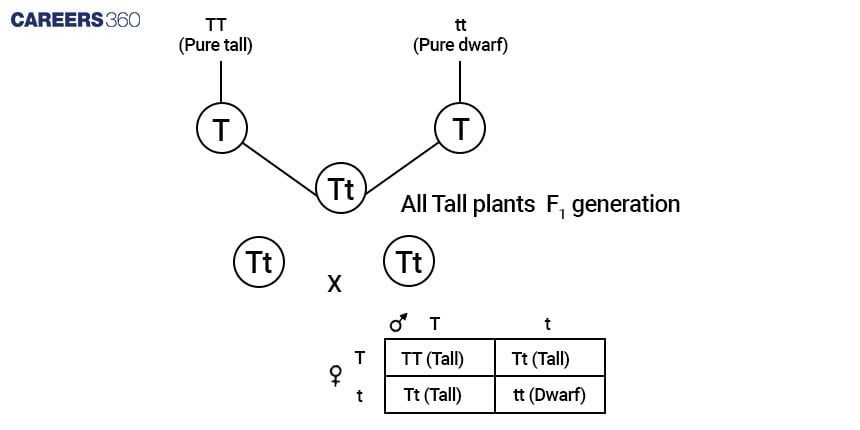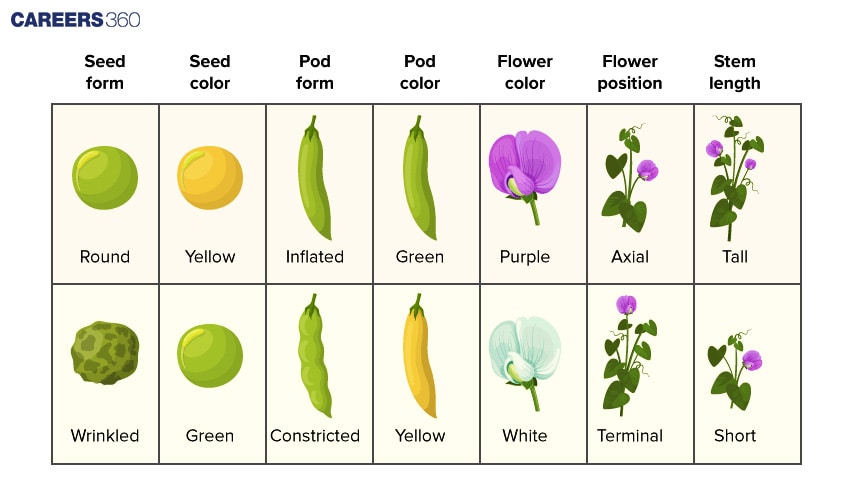Mendel's Law of Dominance: Definition, Examples, diagram, diagram
Mendel’s Experiment And Laws
Gregor Mendel, born in 1822, in Heinzendorf, Austria, is considered the father of genetics. Mendel was grounded in Sciences and Mathematics, which he put into practice during his work on pioneering genetics. It was through his rigorous research on pea plants (Pisum sativum), conducted from 1856 until 1863 in the Augustinian Abbey of St. Thomas at Brno, that laid the foundation of our understanding of heredity.
Don't Miss: Most scoring concepts for NEET | NEET papers with solutions
NEET 2025: Syllabus | PYQs | Crack NEET in 2 months - Study Plan
NEET Important PYQ & Solutions: Physics | Chemistry | Biology | NEET PYQ's (2015-24)
- Mendel’s Experiment And Laws
- Mendel's Experiments With Pea Plants
- The Law Of Dominance

Mendel's approach to experimentation was systematic and original. He chose pea plants because their traits of pea plants are easily observable; secondly, they are self-pollinating, making it possible to closely control breeding experiments. Mendel worked with seven distinct traits, among which were the colour of the flowers, the shape of the seeds, and plant height. He crossed the plants with opposite traits and self-pollinated the progeny through several generations to be able to develop some basic principles of heredity. How he used statistical analysis to interpret the results was quite groundbreaking, really, in biology at that time.
Although overlooked for the findings outright, his work was rediscovered at the turn of the 20th century, which finally gave great stimulus to genetics. Mendel worked out the principles of inheritance—the Law of Dominance, the Law of Segregation, and the Law of Independent Assortment. His works were thus substantiated and supported to eventually become the very foundations of modern-day genetic research and its application in medicine, agriculture, and biotechnology.
Mendel's Experiments With Pea Plants
Gregor Mendel conducted monohybrid cross experiments on pea plants, Pisum sativum, intending to determine the pattern of inheritance. He first carefully selected true-breeding plants expressing certain characteristics in their phenotype, such as the colour of the flower or the shape of a seed. Mendel crossed the pollen of plants having two contrasting characteristics, like purple-flower with white-flower plants and observed the first-generation characteristics of F1. He found that the F1 generation consistently showed only one of the parental traits, which he termed the "dominant" trait—and which the other, "recessive," apparently disappeared.
Mendel had chosen pea plants for his experiments deliberately for several reasons:
First of all, generative time is relatively short in them, and secondly, they produce many offspring. Only on account of these characteristics that belonged to the experimental plant did he succeed in performing a statistical analysis of trait inheritance. Moreover, pea plants have several discrete and easily recognisable traits that occur in only two alternative forms, like round or wrinkled seeds, and tall or short plants. This dichotomy of the characteristics made the research much easier, and clear inferences could be drawn by Mendel regarding the pattern of inheritance. Pea plants are self-pollinating; this helped Mendel manipulate their crossings and ensure the purity of the parental lines.
One important factor contributing to Mendel's success in the outcome of experiments was that he chose his work very wisely. He picked seven traits that displayed dominant-recessive relationships, such as the seed colour. Studying these characters through successive generations, Mendel formulated his principles of heredity. He found that the recessive trait reappears in the second generation in a constant 3:1 ratio and thus formulated his Law of Segregation. This describes the separation of allele pairs during the formation of gametes into the separation so that each of them contains only one allele of the particular trait.
The Law Of Dominance
The first law of Mendel, otherwise known as the Law of Dominance, is one of the central principles of genetics. It states that for any one trait when two different alleles are present in an organism, one allele will be expressed over another. An allele whose expression is seen is called "dominant," whereas one whose expression is masked or hidden is called "recessive." This was derived from Mendel's extended experiments on pea plants, where he had observed a certain regularity in the inheritance of traits of organisms.
Dominant and Recessive Alleles
Dominant alleles: These are alleles that express their trait when one copy is present.
Recessive alleles: This set of alleles causes the expression of their trait only in a homozygous condition. The trait due to the recessive allele is not expressed in the presence of a dominant allele.
For example, Mendel crossed the true-breeding tall pea plants with true-breeding short pea plants. The produced F1 were all tall and of genotype Tt, thus explaining the concept of dominance. In this scenario, the tall allele was considered dominant over the short. However, in developing F2, it returned in the ratio 3:1, thus indicating that both alleles are present in a genotype but only the dominant trait is demonstrated in a phenotype.

Examples of Dominant-Recessive Trait Pairs in Pea Plants:
Seed shape: Round (dominant) vs. wrinkled (recessive)
Flower colour: Purple (dominant) vs. white (recessive)
Pod colour: Green (dominant) vs. yellow (recessive)
Plant height: Tall (dominant) vs. short (recessive)

Table: Examples of Dominant and Recessive Traits in Pea Plants
Trait | Dominant Allele (Symbol) | Recessive Allele (Symbol) |
Seed Shape | Round (R) | Tall (T) |
Flower Color | Purple (P) | White (p) |
Pod Color | Green (G) | Yellow (g) |
Plant Height | Tall (T) | Short (t) |
Understanding Mendel's Law of Dominance is crucial for grasping the basics of genetic inheritance. This principle helps explain why certain traits appear in offspring while others do not, even though the genetic information for both traits is present. By observing the patterns of dominant and recessive traits, Mendel was able to predict the outcomes of genetic crosses, laying the groundwork for modern genetics.
The video recommended on Mendel's Law of Dominance:
Frequently Asked Questions (FAQs)
Mendel's Law of Dominance states that for any pair of different forms of a gene, one will be dominant, and another is recessive; the recessive allele is masked in organism phenotype by expression of the dominant allele.
Mendel built the laws of heredity based on systematic crossings of pea plants and a careful study of the characteristics of thousands of their offspring for several generations.
Dominant traits are those that become manifest in the presence of the dominant allele. On the other hand, recessive traits refer to those manifesting only when both alleles for the said trait are recessive.
The pea plant experiments by Mendel were important in the sense that, scientifically, they explained how traits were passed; thus laying the base for the establishment of the central laws of genetics.
Mendel's Law of Dominance applies to human genetics by explaining how certain traits, for example, eye colour or blood type, are passed down to offspring or why some traits can be masked by others in offspring.
Also Read
29 Nov'24 01:16 PM
28 Nov'24 07:59 PM
28 Nov'24 09:47 AM
25 Nov'24 04:19 PM
25 Nov'24 12:57 PM
25 Nov'24 10:59 AM
23 Nov'24 04:11 PM
21 Nov'24 03:51 PM
16 Nov'24 10:51 AM